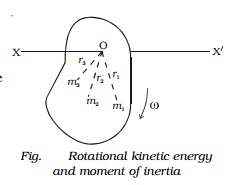Chapter: 11th 12th std standard Class Physics sciense Higher secondary school College Notes
Rotational kinetic energy and moment of inertia of a rigid body

Moment
of inertia and its physical significance
According to Newton?s first law of motion, a
body must continue in its state of rest or of uniform motion unless it is
compelled by some external agency called force. The inability of a material
body to change its state of rest or of uniform motion by itself is called
inertia. Inertia is the fundamental property of the matter. For a given force,
the greater the mass, the higher will be the opposition for motion, or larger
the inertia. Thus, in translatory motion, the mass of the body measures the
coefficient of inertia.
Similarly, in rotational motion also, a body,
which is free to rotate about a given axis, opposes any change desired to be
produced in its state. The measure of opposition will depend on the mass of the
body and the distribution of mass about the axis of rotation. The coefficient
of inertia in rotational motion is called the moment of inertia of the body
about the given axis.
Moment of inertia plays the same role in
rotational motion as that of mass in translatory motion. Also, to bring about a
change in the state of rotation, torque has to be applied.
Rotational
kinetic energy and moment of inertia of a rigid body
Consider a rigid body rotating with angular
velocity ω about an axis XOX′. Consider the particles of masses m1, m2, m3?
situated at distances r1, r 2,
r3? respectively from the axis of rotation. The angular velocity
of all the particles is same but the
particles rotate with different linear velocities. Let the linear velocities of
the particles be v1,v2,v3
? respectively.

Kinetic energy of the first particle = ? m1v12
But v1=r1ω
∴
Kinetic energy of the first particle
=1/2 . m1(r1ω)2
=1/2 . m2(r2ω)2
Similarly,
Kinetic energy of second particle
=1/2 m2r22w2
Kinetic energy of third particle
= 1 / 2 . m3r32ω2
and so on.
The kinetic energy of the rotating rigid body is
equal to the sum of the kinetic energies of all the particles.
∴
Rotational kinetic energy
= 1 / 2 . ( m1r12ω2 + m2r22ω2
+ m3r32ω2 + ???. + mnrn2ω2)
= 1 / 2 . ω2 ( m1r12 + m2r22 +
m3r32 + ???. + mnrn2)
In translatory motion, kinetic energy = 1 /2 mv2
Comparing with the above
equation, the inertial role is played by the term ∑ mnrn2.
This is known as moment of inertia of the rotating rigid body about the axis of
rotation. Therefore the moment of inertia is I = mass ? (distance )2
Kinetic energy of rotation =
1/2 ω2I
When ω = 1 rad s-1,
rotational kinetic energy
= ER = 1/2 (1)2I
(or) I = 2ER
It shows that moment of
inertia of a body is equal to twice the kinetic energy of a rotating body whose
angular velocity is one radian per second.
The unit for moment of
inertia is kg m2 and the dimensional formula is ML2.
Radius
of gyration
The moment of inertia of the rotating rigid body is,
I = ∑ miri2 = m1r12
+ m1r12 + ?? + mnrn2
If the particles of the rigid body are having same
mass, then
m1 = m2 = m3 =?.. =
m (say)
∴
The above equation becomes,
I = nm[ r12 + r22
+?..+ rn2]/n
where n is the number of particles in the rigid
body.
∴
I = MK2
where M = nm, total mass of the body and K 2
= [ r12 + r22 +?..+ rn2]/n
Here K is called as the radius of gyration of the
rigid body about the axis of rotation.
The radius of gyration is equal to the root mean
square distances of the particles from the axis of rotation of the body.
The radius of gyration can also be defined as the
perpendicular distance between the axis of rotation and the point where the
whole weight of the body is to be concentrated.
Also from the equation (2) K2 = r/M
Related Topics